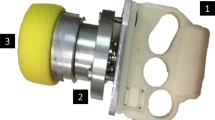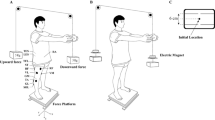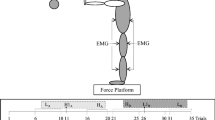Abstract
Purpose
Many studies have investigated postural reactions (PR) to body-delivered perturbations. However, attention has been focused on the descriptive variables of the PR rather than on the characterization of the perturbation. This study aimed to test the hypothesis that the impulse rather than the force magnitude of the perturbation mostly affects the PR in terms of displacement of the center of foot pressure (ΔCoP).
Methods
Fourteen healthy young adults (7 males and 7 females) received 2 series of 20 perturbations, delivered to the back in the anterior direction, at mid-scapular level, while standing on a force platform. In one series, the perturbations had the same force magnitude (40 N) but different impulse (range: 2–10 Ns). In the other series, the perturbations had the same impulse (5 Ns) but different force magnitude (20–100 N). A simple model of postural control restricted to the sagittal plane was also developed.
Results
The results showed that ΔCoP and impulse were highly correlated (on average: r = 0.96), while the correlation ΔCoP–force magnitude was poor (r = 0.48) and not statistically significant in most subjects. The normalized response, ΔCoPn = ΔCoP/I, was independent of the perturbation magnitude in a wide range of force amplitude and impulse and exhibited good repeatability across different sets of stimuli (on average: ICC = 0.88). These results were confirmed by simulations.
Conclusion
The present findings support the concept that the magnitude of the applied force alone is a poor descriptor of trunk-delivered perturbations and suggest that the impulse should be considered instead.








Similar content being viewed by others
References
Azzi NM, Coelho DB, Teixeira LA (2017) Automatic postural responses are generated according to feet orientation and perturbation magnitude. Gait Posture 57:172–176. https://doi.org/10.1016/j.gaitpost.2017.06.003
Boonstra TA, Schouten AC, Van Der Kooij H (2013) Identification of the contribution of the ankle and hip joints to multi-segmental balance control. J Neuroeng Rehabil 10:23. https://doi.org/10.1109/TNSRE.2014.2372172
Bortolami SB, DiZio P, Rabin E, Lackner JR (2003) Analysis of human postural responses to recoverable falls. Exp Brain Res 151:387–404. https://doi.org/10.1007/s00221-003-1481-x
Chen B, Lee YJ, Aruin AS (2017) Role of point of application of perturbation in control of vertical posture. Exp Brain Res 235:3449–3457. https://doi.org/10.1007/s00221-017-5069-2
Colebatch JG, Govender S (2019) Responses to anterior and posterior perturbations in Parkinson’s disease with early postural instability: role of axial and limb rigidity. Exp Brain Res 237:1853–1867. https://doi.org/10.1007/s00221-019-05553-8
Colebatch JG, Govender S, Dennis DL (2016) Postural responses to anterior and posterior perturbations applied to the upper trunk of standing human subjects. Exp Brain Res 234:367–376. https://doi.org/10.1007/s00221-015-4442-2
Diener HC, Horak FB, Nashner LM (1988) Influence of stimulus parameters on human postural responses. J Neurophysiol 59:1888–1905. https://doi.org/10.1152/jn.1988.59.6.1888
Dvir Z, Paterna M, Quargnenti M et al (2020) Linearity and repeatability of postural responses in relation to peak force and impulse of manually delivered perturbations : a preliminary study. Eur J Appl Physiol 120:1319–1330. https://doi.org/10.1007/s00421-020-04364-y
Engelhart D, Schouten AC, Aarts RGKM, Van Der Kooij H (2015) Assessment of multi-joint coordination and adaptation in standing balance : a novel device and system identification technique. IEEE Trans Neural Syst Rehabil Eng 23:973–982. https://doi.org/10.1109/TNSRE.2014.2372172
Ferraresi C, De Benedictis C, Muscolo GG et al (2020a) Development of an automatic perturbator for dynamic posturographic analysis. Mech Ans Mach Sci 93:273–282. https://doi.org/10.1007/978-3-030-58104-6
Ferraresi C, Maffiodo D, Franco W et al (2020b) Hardware-in-the-loop equipment for the development of an automatic perturbator for clinical evaluation of human balance control. Appl Sci 10:8886. https://doi.org/10.3390/app10248886
Forghani A, Preuss R, Milner TE (2017) Effects of amplitude and predictability of perturbations to the arm on anticipatory and reactionary muscle responses to maintain balance. J Electromyogr Kinesiol 35:30–39. https://doi.org/10.1016/j.jelekin.2017.05.006
Fujimoto M, Bair WN, Rogers MW (2015) Center of pressure control for balance maintenance during lateral waist-pull perturbations in older adults. J Biomech 48:963–968. https://doi.org/10.1016/j.jbiomech.2015.02.012
Goodworth AD, Peterka RJ (2018) Identifying mechanisms of stance control : A single stimulus multiple output model-fit approach. J Neurosci Methods 296:44–56. https://doi.org/10.1016/j.jneumeth.2017.12.015
Grassi L, Rossi S, Studer V et al (2017) Quantification of postural stability in minimally disabled multiple sclerosis patients by means of dynamic posturography: an observational study. J Neuroeng Rehabil 14:4. https://doi.org/10.1186/s12984-016-0216-8
Horak FB, Nashner LM (1986) Central programming of postural movements: adaptation to altered support-surface configurations. J Neurophysiol 55:1369–1381. https://doi.org/10.1152/jn.1986.55.6.1369
Ivanenko Y, Gurfinkel VS (2018) Human postural control. Front Neurosci 12:171. https://doi.org/10.3389/fnins.2018.00171
Kim J, Kim C, Lee J et al (2009) Human postural control against external force perturbation applied to the high-back. Int J Precis Eng Manuf 10:147–151. https://doi.org/10.1007/s12541-009-0083-3
Kim S, Atkeson CG, Park S (2012) Perturbation-dependent selection of postural feedback gain and its scaling. J Biomech 45:1379–1386. https://doi.org/10.1016/j.jbiomech.2012.03.001
Maaswinkel E, Griffioen M, Perez RSGM, van Dieën JH (2016) Methods for assessment of trunk stabilization, a systematic review. J Electromyogr Kinesiol 26:18–35. https://doi.org/10.1016/j.jelekin.2015.12.010
Maffiodo D, Franco W, De Benedictis C et al (2020) Pneumo-tronic perturbator for the study of human postural responses. Adv Intell Syst Comput 980:374–383. https://doi.org/10.1007/978-3-030-19648-6_43
Martinelli AR, Coelho DB, Magalhães FH et al (2015) Light touch modulates balance recovery following perturbation: from fast response to stance restabilization. Exp Brain Res 233:1399–1408. https://doi.org/10.1007/s00221-015-4214-z
Morasso PG, Baratto L, Capra R, Spada G (1999) Internal models in the control of posture. Neural Netw 12:1173–1180. https://doi.org/10.1016/S0893-6080(99)00058-1
Pacheco Quiñones D, Paterna M, De Benedictis C (2021) Automatic electromechanical perturbator for postural control analysis based on model predictive control. Appl Sci 11:4090. https://doi.org/10.3390/app11094090
Pasman EP, McKeown MJ, Cleworth TW et al (2019) A novel MRI compatible balance simulator to detect postural instability in parkinson’s disease. Front Neurol 10:922. https://doi.org/10.3389/fneur.2019.00922
Pidcoe PE, Rogers MW (1998) A closed-loop stepper motor waist-pull system for inducing protective stepping in humans. J Biomech 31:377–381. https://doi.org/10.1016/S0021-9290(98)00017-7
Robbins SM, Caplan RM, Aponte DI, St-Onge N (2017) Test-retest reliability of a balance testing protocol with external perturbations in young healthy adults. Gait Posture 58:433–439. https://doi.org/10.1016/j.gaitpost.2017.09.007
Robert T, Vallee P, Tisserand R (2018) Stepping boundary of external force-controlled perturbations of varying durations : comparison of experimental data and model simulations. J Biomech 75:89–95. https://doi.org/10.1016/j.jbiomech.2018.05.010
Schmidt D, Germano AMC, Milani TL (2015) Aspects of dynamic balance responses: inter- and intra-day reliability. PLoS ONE 10:e0136551. https://doi.org/10.1371/journal.pone.0136551
Shumway-Cook A, Woollacott MH (2007) Motor control: translating research into clinical practice, 3rd edn. Lippincott Williams & Wilkins, Philadelphia
Sturnieks DL, Menant J, Delbaere K et al (2013) Force-controlled balance perturbations associated with falls in older people: a prospective cohort study. PLoS ONE 8:e70981. https://doi.org/10.1371/journal.pone.0070981
Teixeira LA, Azzi N, de Oliveira JÁ et al (2019) Automatic postural responses are scaled from the association between online feedback and feedforward control. Eur J Neurosci. https://doi.org/10.1111/ejn.14625
Van Der Kooij H, Peterka RJ (2011) Non-linear stimulus-response behavior of the human stance control system is predicted by optimization of a system with sensory and motor noise. J Comput Neurosci 30:759–778. https://doi.org/10.1007/s10827-010-0291-y
Van Der Kooij H, Van Asseldonk E, Van Der Helm FCT (2005) Comparison of different methods to identify and quantify balance control. J Neurosci Methods 145:175–203. https://doi.org/10.1016/j.jneumeth.2005.01.003
Winter DA, Patla AE, Prince F et al (1998) Stiffness control of balance in quiet standing. J Neurophysiol 80:1211–1221. https://doi.org/10.1152/jn.1998.80.3.1211
Acknowledgements
This work was supported by grants from “Fondo Europeo di sviluppo regionale – Regione Liguria” (ROAS_RIC_COMP_17_01) and by “Proof of Concept” Project 2018, the Politecnico di Torino. Funding sources had no role in the conduction of the study.
Author information
Authors and Affiliations
Contributions
MP, ZD, CF and SR conceptualized the study; MP ran the experiments and analyzed the data; MP, CdB implemented the mechanical model; MP, CdB, DM, WF and SR interpreted the data; MP CdB and SR drafted the manuscript; all authors critically revised and approved the final version of the manuscript and agreed to be accountable for all aspects of the work.
Corresponding author
Ethics declarations
Conflict of interest
The authors have no conflict to disclose.
Additional information
Communicated by Andrew Cresswell.
Publisher's Note
Springer Nature remains neutral with regard to jurisdictional claims in published maps and institutional affiliations.
Rights and permissions
About this article
Cite this article
Paterna, M., Dvir, Z., De Benedictis, C. et al. Center of pressure displacement due to graded controlled perturbations to the trunk in standing subjects: the force–impulse paradigm. Eur J Appl Physiol 122, 425–435 (2022). https://doi.org/10.1007/s00421-021-04844-9
Received:
Accepted:
Published:
Issue Date:
DOI: https://doi.org/10.1007/s00421-021-04844-9




